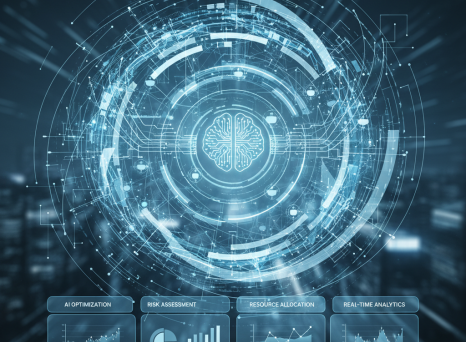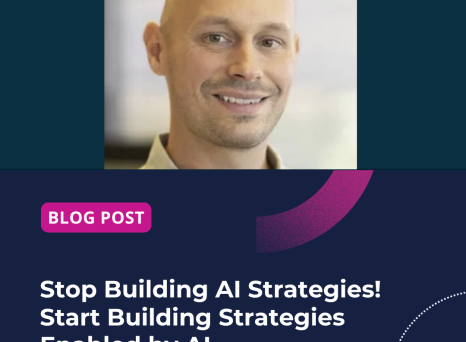What if your biggest competitive advantage wasn’t faster execution, but smarter decisions? That is the promise of Artificial Intelligence in the project economy. The conversation has shifted to understand how deeply AI will transform the way humans and technology work together in PPM.
Pierre Demonsant, Executive Chairman and Co-founder of Planisware, offers an ambitious perspective on how AI is set to redefine project portfolio management (PPM). Not to be only used for productivity, but as a complete rethinking of how humans and technology interact.
The Foundational Shift of Language over Logic
“If you really want to take advantage of this new world of AI, you need to bring more language into your PPM.”
Project management systems have long been anchored in numerical data, like in budgets, schedules, resource allocations. Yet today’s AI thrives on language-based reasoning such as meeting notes, decision rationales, contextual nuances. These are insights that have historically lived outside structured platforms. For Demonsant, the future lies in uniting these two worlds, where numbers and narrative converge into a single, intelligent ecosystem.
However, to train AI meaningfully, organizations must begin integrating unstructured, language-rich data into their portfolio environments. Planisware has long anticipated this evolution, encouraging enterprises to enrich their systems with these previously overlooked data streams. With this deeper, contextual input, AI can move beyond the role of a passive calculator to become an active co-pilot, one capable of shaping, guiding, and elevating decision-making in real time.
Bridging A Unified Platform
That is why Planisware is focusing on a new “AI-powered unified platform.” that will serve as the foundation for future versions of all Planisware products.
Demonsant describes this platform as a merger between the “old world” of AI, like the rule-based systems mentioned before and the “new world” of generative intelligence and language models. The platform is designed to recognize much more than data analysis but true value. This ambition is a future where both the intent and conversation are merging with configuration and command lines.
As Microsoft CEO Satya Nadella’s statement summarize, the decline of SaaS interfaces showcases that at the age of AI agents, software might outgrow altogether.
“The way people interact with software in the near future will be very different,” Demonsant explains. He predicts that within 3–5 years, 40–60% of users will interact with software by talking or writing, bypassing the interface altogether.
And to those who doubt it, he reminds them that people once thought the internet would never work. “Some people were laughing,” he recalls. “Now look where we are.”
What A New World Looks Like
In technical terms, Planisware’s shift involves layering a semantic model on top of its current architecture. The familiar trio of database + in-memory server + UI is being enhanced by a layer that understands meaning.
This semantic model defines:
Project objects (tasks, resources, risks)
Actions users can perform
Relationships between entities
Instead of clicking through dozens of tabs or configuring dashboards manually, future users may:
Request insights via chat
Ask the system to generate scenarios
Rely on AI to recall past project learnings instantly
Central to this vision is Oscar, Planisware’s agentic AI assistant. Oscar uses large language models to power natural-language interaction while drawing on enterprise-specific documentation—bringing the benefit of contextual AI into the everyday workflow.
Behind Oscar is the LLM Connector, which integrates external or custom-trained language models securely into Planisware workflows. It enhances assistance, summarization, and intelligent project guidance, all while maintaining enterprise-grade governance.
By encoding this knowledge, Planisware will enable AI agents to “understand” a user’s request like creating a new project for a department and autonomously build the necessary configurations. The agent might even return relevant templates, similar work breakdown structures (WBS), or capacity dashboards, all through natural language dialogue.
Still Early, But Not Abstract
Demonsant stresses that while the vision is bold, execution must be cautious.
“If you bring something that doesn’t provide a good answer, we will not have success with this kind of tool,”
Planisware has been developing and rigorously testing new language capabilities for more than two years, with AI embedded in its products since the early 1990s. The company has pioneered the adoption of multiple AI techniques in the project world, with solutions that thrive to be as accurate, as trustworthy, and as genuinely useful as possible to project leaders facing complex, real-world decisions.
As we all have come to realize, this future enhances project leaders to come to faster, more accurate conclusions, as human expertise continues to remain important. By letting AI handle the operational overhead, users can shift their focus toward higher-level strategy, judgment, and value creation.
Planisware’s AI Vision
At Planisware, we’re clear-eyed about its impact. It won’t transform everything overnight. Instead, it will embed itself step by step into daily workflows, until it’s no longer seen as “AI” at all, but simply the standard way of operating with greater speed, precision, and clarity.
“An estimated 90% of all organizations are currently undergoing some kind of digital transformation. If you are reading this today, you are part of those 90%.”
This is why Planisware is leading the way in defining how it will shape the future of project portfolio management. Curious to learn more about Planisware’s AI capabilities? Get in touch with us here.



